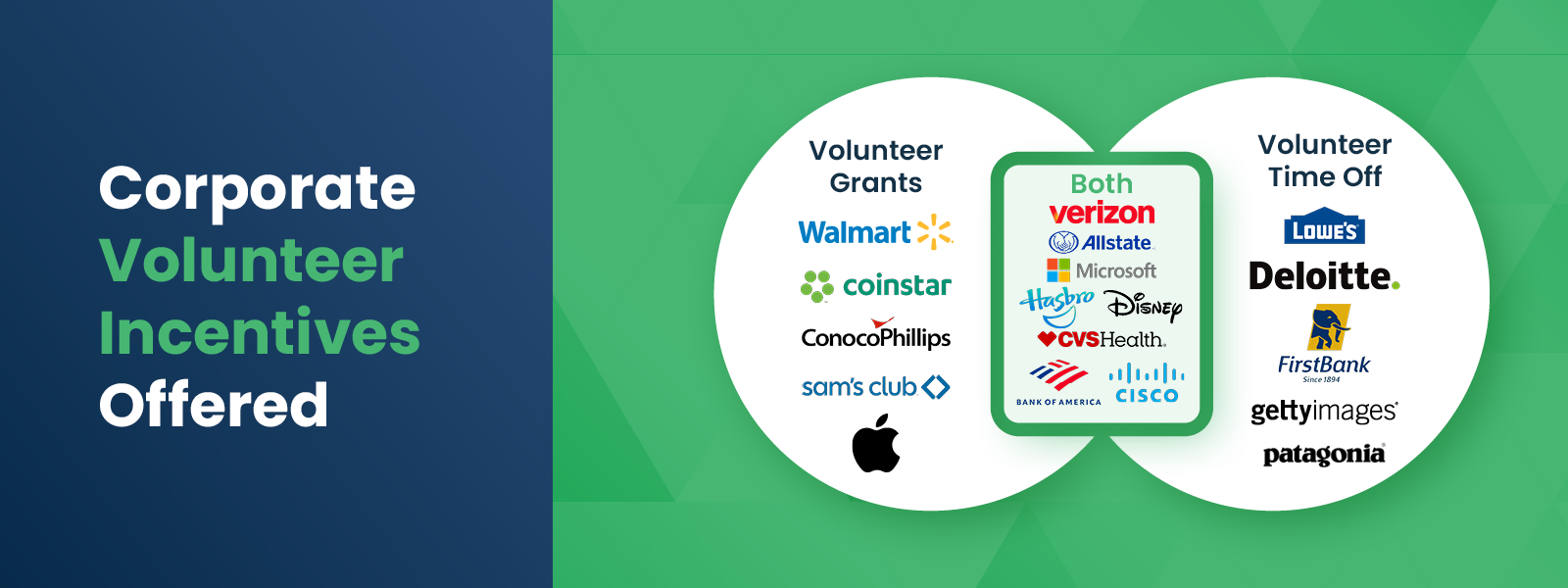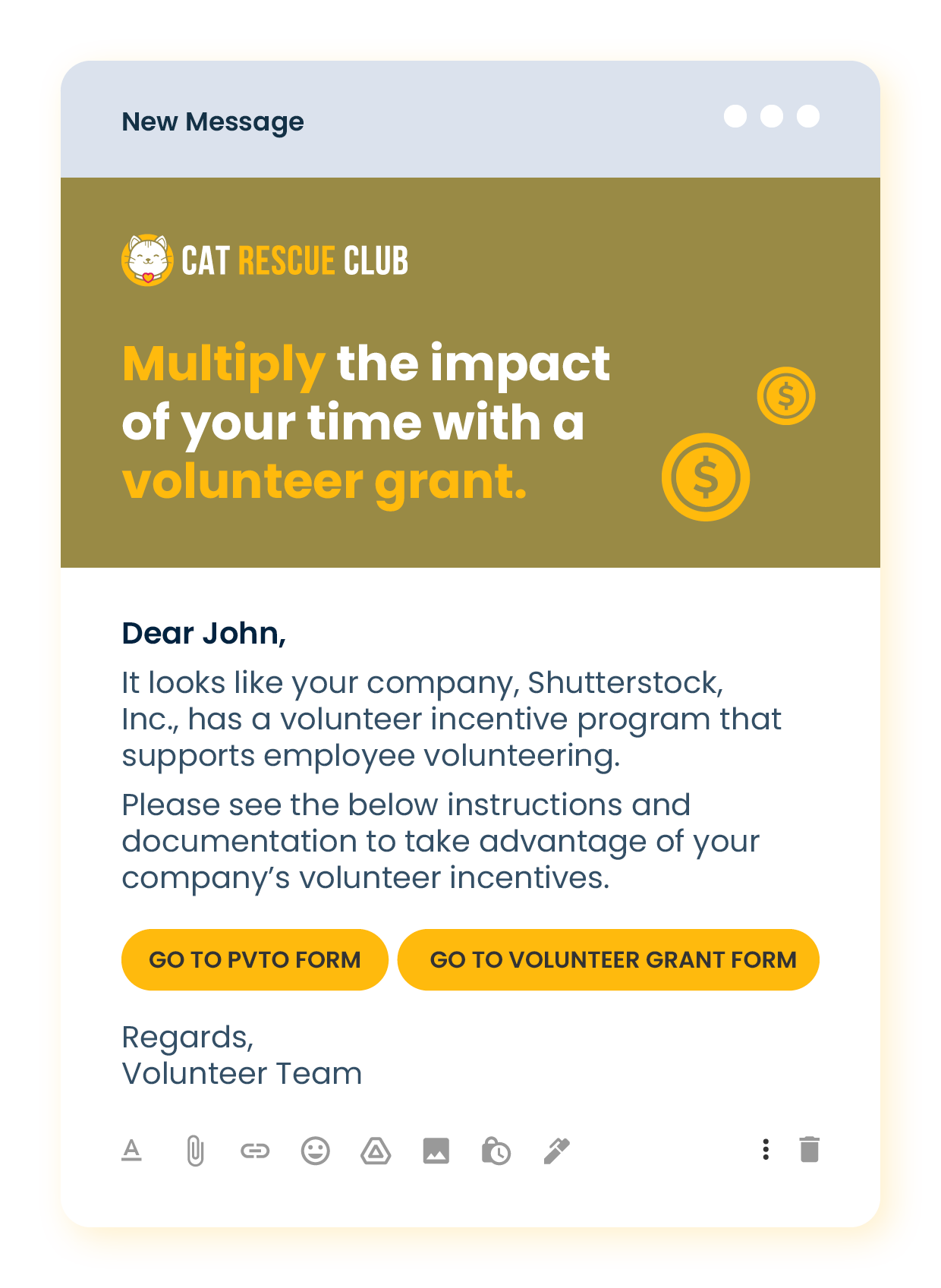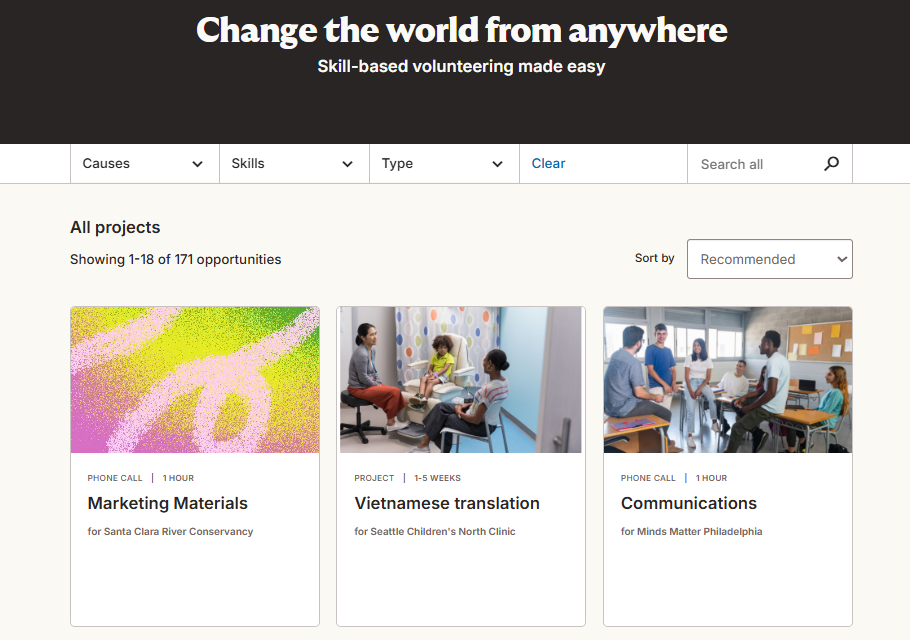How to Get Corporate Volunteers and Source Lasting Partners
Corporate volunteers are an incredible resource for nonprofits, offering both manpower and expertise to help advance your mission. However, attracting and retaining these individuals and groups requires strategic planning and clear communication about the benefits to both the organization and the volunteers themselves.
If you’re wondering how to get more corporate volunteers for your cause, this guide will provide you with actionable insights on sourcing and engaging them effectively, as well as tips on building lasting partnerships. Specifically, we’ll cover:
- Why do corporate volunteers matter for nonprofits?
- 8 Effective ways to source corporate volunteers
- Engaging and retaining corporate volunteers in your nonprofit’s program
- Sourcing corporate volunteers: FAQs
Ready to walk through the key steps and strategies that can help you tap into the full potential of corporate volunteers, from identifying potential partners to keeping them engaged in your mission long-term? Let’s begin!
Why do corporate volunteers matter for nonprofits?
Corporate volunteers are an invaluable resource for nonprofits, providing more than just extra hands on the ground. Beyond their time and labor, corporate volunteers bring expertise, networks, and energy that can help your organization expand its impact and reach. Engaging corporate volunteers effectively can strengthen your programs, enhance your nonprofit’s visibility, and foster lasting partnerships that benefit both your mission and the companies involved.
Here are the main reasons why corporate volunteers matter for nonprofits like yours:
- Expanded manpower and resources: Corporate volunteers enable your nonprofit to tackle larger projects or serve more beneficiaries without significantly increasing costs.
- Specialized skills and expertise: Many corporate volunteers bring professional experience in areas like marketing, IT, finance, or project management that can strengthen your programs and operations.
- Increased community visibility: Employees volunteering for your cause often share their experiences with colleagues, friends, and social networks, amplifying awareness of your nonprofit.
- Enhanced supporter relationships: Corporate volunteers often become more personally invested in your mission, increasing the likelihood that they will support your organization through donations in addition to their time.
- Stronger partnerships with companies: Engaging employees in volunteer programs can lead to long-term corporate partnerships, including financial support, matching gift contributions, and sponsorship opportunities.
By understanding the value that corporate volunteers bring, nonprofits can design programs that maximize both impact and engagement. When leveraged strategically, corporate volunteer programs not only extend your organization’s capacity but also cultivate meaningful, long-term partnerships that benefit your nonprofit, your volunteers, and the communities you serve.
8 Effective ways to source corporate volunteers
Now that we’ve established why corporate volunteers are essential, let’s dive into how you can attract and source them for your nonprofit’s initiatives. Implementing a comprehensive strategy will increase your chances of creating strong, lasting partnerships with corporate volunteers. Here’s what we recommend.
1) Create a Compelling Volunteer Program
To attract corporate volunteers, you need to first make the volunteer program appealing. Develop structured, engaging volunteer opportunities that not only provide value to your nonprofit but also benefit employees. Some companies may prefer group volunteer events where team members can work together, while others may be interested in skill-based volunteer opportunities.
For the best results, provide clear expectations, timelines, and outcomes for each project. The easier it is for companies and volunteers to understand the impact they will have and the logistics involved, the more likely they are to participate.
Quick Tip: Consider offering flexible volunteer opportunities, including virtual volunteering or skills-based projects, to appeal to a wider variety of companies and employee schedules.
2) Research Companies with Established Volunteer Programs
The first step in sourcing corporate volunteers is to identify companies with established volunteer programs. Many businesses offer employees paid time off to volunteer, or they may have set days for volunteering as part of their company culture.
Start by researching businesses in your local area, industry sectors relevant to your mission, or those known for their philanthropy. A simple online search (i.e., “companies with volunteer programs near me”) can provide valuable insights into which companies are engaged in CSR and actively seek partnerships with nonprofits.
Looking for some examples? Companies with volunteer grant programs include Walmart, Coinstar, ConocoPhillips, Apple, and Sam’s Club.
Meanwhile, employers with volunteer time off policies include Lowe’s, Deloitte, FirstBank, Getty Images, and Patagonia.
And businesses with both types of volunteer programs include Verizon, Allstate, Microsoft, Hasbro, Disney, CVS Health, Bank of America, and Cisco Systems.
Quick Tip: Consider reaching out to companies with a history of supporting causes similar to yours. If your organization focuses on education, for example, look for companies with established programs in this area.
3) Leverage Industry Networks
Networking is an essential tool when it comes to sourcing corporate volunteers. Leverage your professional networks, chambers of commerce, or even platforms like LinkedIn to reach out to business leaders and community-oriented companies. By attending industry events, trade shows, or community gatherings, you can directly network with professionals who may want to give back in a meaningful way through corporate volunteering.
Did You Know? Companies that volunteer with nonprofits often see an increase in employee satisfaction and retention. Corporate volunteer programs offer employees a chance to work together outside of their usual work environment, fostering stronger team bonds.
4) Use Your Current Donor and Volunteer Base
Your existing network of donors, volunteers, and board members can be a powerful resource when sourcing corporate volunteers. After all, many of your current supporters may work for companies that offer volunteer grants or volunteer time off programs. You can encourage them to leverage their workplace volunteering benefits by explaining how they could get involved.
Consider sending an email like this:
For the best results, try creating outreach campaigns or personalized appeals that highlight the impact of corporate volunteerism, both for the nonprofit and for the companies involved. This can help you tap into an existing pool of potential volunteers with the added advantage of personal connections. Make sure the content is as tailored as possible, providing precise information about an individual’s corporate program opportunities and direct links to get involved.
Hear what the YMCA of Greater Cincinnati has to say:
5) Reach Out Directly to Corporations
Sometimes, the most effective way to get corporate volunteers is to approach companies directly. Don’t be afraid to cold email or call HR departments, employee engagement teams, or CSR managers. But also check whether you already have a connection! Your existing donors and volunteers may be willing to provide a warm introduction to their employer, helping you get your foot in the door with ease. Be clear about your mission, the kind of volunteer support you need, and how the partnership can benefit the company.
When reaching out to corporations, make sure your communication is tailored to the specific company you’re targeting. Highlight why their employees would be a great fit for your nonprofit and how their participation aligns with the company’s values.
Businesses are more likely to engage in corporate volunteerism if they can see the tangible benefits for their employees and company culture. When reaching out, highlight the value of corporate volunteering for the company: the positive impact on employee engagement, team-building, skill development, and enhanced brand reputation. This mutual benefit will make it easier to gain corporate support.
6) Approach Local Businesses and Startups
While large corporations may seem like the obvious target for corporate volunteering, local businesses and startups can also be great partners. These businesses may be looking for ways to make a social impact and engage employees in meaningful work right in your community.
Many small businesses and startups are interested in community involvement, but don’t have the same large-scale programs as larger corporations. Offering a volunteer program can help them establish a strong reputation in the community. Therefore, try pitching volunteer opportunities as a team-building experience. Local businesses often seek ways to boost employee morale and collaboration. By positioning your volunteer opportunities as team-building exercises, you can attract small and mid-sized companies looking for meaningful ways to engage their employees.
7) Tap into Employee Resource Groups
Employee Resource Groups (or ERGs) are internal networks within companies that support underrepresented groups, such as women, veterans, or people of color. ERGs are often looking for ways to engage in community outreach and corporate volunteerism. Therefore, reach out to the ERGs within companies to offer volunteer opportunities aligned with their group’s mission. For example, if you are an LGBT-focused nonprofit, a company’s ERG for queer and allied employees might be interested in volunteering.
8) Use Job Boards and Volunteer Platforms
There are a variety of online platforms that connect corporations with nonprofit organizations. Many job boards and volunteer platforms feature corporate volunteer programs, where companies and their employees can sign up to help local charities.
For example, dedicated platforms allow nonprofits to post specific volunteer opportunities that companies can access. By using these platforms, you can attract corporate teams who are looking for group volunteering activities.
Engaging and retaining corporate volunteers in your nonprofit’s program
Attracting corporate volunteers is only the first step. Retaining them and building long-term partnerships is where the real value lies.
To ensure the ongoing success of your corporate volunteer program, focus on creating a meaningful and rewarding experience for corporate volunteers.
1) Provide Recognition and Feedback
Acknowledging and appreciating corporate volunteers is essential for retaining them. Regular recognition and gratitude help volunteers feel valued and encourage them to return for future opportunities.
For the best results, provide feedback on their efforts so that they can continue to improve over time.
2) Offer Long-Term Engagement Opportunities
Rather than focusing on one-time volunteer events, provide opportunities for ongoing engagement. For example, invite corporate volunteers to participate in long-term projects, mentor employees or community members, or even take on leadership roles in certain initiatives.
3) Foster a Sense of Community
Corporate volunteers will stay engaged longer if they feel like part of a community. Build a strong culture of volunteerism by facilitating networking, creating social events, and keeping volunteers informed about the impact of their work. This sense of community will make them feel more connected to your nonprofit and more motivated to stay involved.
4) Explore Ongoing Corporate Volunteer Partnerships
One of the most powerful ways to engage and retain corporate volunteers is by developing strong partnerships with their employers. When volunteers feel supported by their companies, they are more likely to stay engaged and continue participating in your nonprofit’s initiatives. This creates a win-win situation where both your organization and the corporation benefit from the collaboration. Additionally, volunteers can play a key role in advocating for corporate volunteerism within their workplace, helping to secure long-term support and increase participation across their company.
5) Focus on Tangible Volunteer Impact
Corporate volunteers are most engaged when they can see the real difference their time and skills make. Highlighting tangible outcomes not only motivates volunteers to continue participating but also strengthens your nonprofit’s credibility with corporate partners. Demonstrating measurable impact is key to building long-term relationships and reinforcing the value of corporate volunteer programs.
6) Explore Other Workplace Giving Opportunities
Oftentimes, corporate volunteering is just one of many ways employees can support your nonprofit. Encouraging volunteers to explore additional workplace giving programs can deepen their engagement while maximizing your organization’s impact. After all, many companies offer multiple avenues for employees to give back, in addition to volunteer programs, such as payroll giving, matching gifts, and more. By educating volunteers about these opportunities, you help them make a bigger difference, foster long-term support, and turn volunteers into donors for your mission.
Sourcing corporate volunteers: FAQs
Looking to learn more about how you can get corporate volunteers for your organization’s next event? Browse the following frequently asked questions by nonprofits like yours:
How do I find companies in my area that offer corporate volunteer programs?
You can start by conducting an online search for “corporate volunteer programs near me” or by looking for local chambers of commerce and business directories. Additionally, explore websites of large corporations, as many list their corporate social responsibility initiatives, including volunteer opportunities. Alternatively, consider investing in a volunteer program database like Double the Donation, which compiles information on thousands of companies’ philanthropy initiatives, including volunteer grants and VTO, making it readily available via a quick search in the plugin tool.
What’s the difference between volunteer grants and volunteer time off (VTO)?
Volunteer grants are financial contributions made by companies to nonprofits in exchange for employee volunteer hours, while VTO is paid time off that companies provide to employees for volunteer activities. Both are valuable benefits, but they serve different purposes: volunteer grants provide funding to nonprofits, and VTO offers employees time away from work to volunteer.
How can I create a volunteer program that appeals to corporate volunteers?
To attract corporate volunteers, focus on creating structured, skill-based opportunities that align with both your nonprofit’s needs and the interests of the company’s employees. Offering flexible volunteer opportunities, including virtual or group projects, can also be key to attracting diverse volunteers.
What are some examples of companies that have strong corporate volunteer programs?
Companies like Microsoft, CVS Health, Bank of America, and Patagonia are well-known for their robust corporate volunteer programs. These companies often provide paid volunteer time, individual and team volunteer grants, and other ways for their employees to contribute to community causes.
How can I retain corporate volunteers over the long term?
To retain corporate volunteers, focus on providing meaningful, ongoing engagement opportunities. Recognizing their contributions, offering long-term projects, and fostering a sense of community can all help keep volunteers connected to your nonprofit and motivated to return.
How do I measure the impact of corporate volunteerism for my nonprofit?
It’s essential to track the outcomes of your volunteer programs to show the tangible impact on your mission. This can include corporate volunteer metrics like the number of volunteer hours contributed, the specific projects completed, or improvements in organizational capacity. From there, sharing these results with corporate partners can help strengthen the partnership.
Wrapping Up & Next Steps
Attracting and retaining corporate volunteers is an essential strategy for any nonprofit looking to expand its reach and impact. By targeting the right companies, offering meaningful volunteer opportunities, and maintaining strong relationships with corporate partners, you can create a sustainable volunteer program that benefits both your nonprofit and the corporations involved.
Start by researching potential corporate partners, crafting compelling outreach messages, and fostering long-term engagement. Remember: the key to success lies in creating a program that is mutually beneficial for your nonprofit, its corporate partners, and the individuals who ultimately volunteer.








